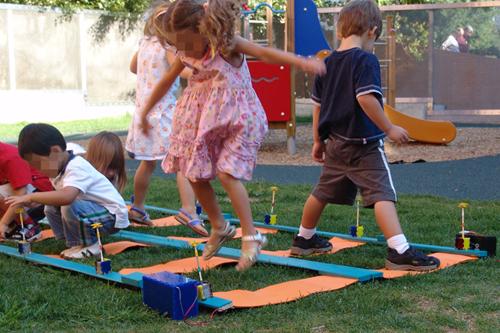
We explore how an interactive pathway impacts children’s play patterns in outdoor playgrounds. The paper describes our experience designing and testing the prototype at various stages of development with twenty children age three to five enrolled in a preschool childcare center. We provide examples of the children’s diverse play patterns and conclude with initial reflections on the design of responsive playground elements.
Digital technologies have entered almost all areas of children’s lives including entertainment, museums, and toys. Until recently, playgrounds stayed technology- free. With the increasing availability of technologies for outdoor interaction, we envision that digitally enhanced equipment will be incorporated into playgrounds in the near future. In an effort to explore this emerging field, we designed an interactive prototype, conducted (participatory) field probes, and categorized observed play patterns.
Working outdoor poses an additional challenge for children’s technology developers, but some like the Ambient Wood Project have successfully integrated new tools for learning into the natural environment [11]. Fewer researchers have addressed outdoor playspaces. In Spain a group of researchers designed an interactive, outdoor water play installation for the “Universal Forum of Cultures” held in Barcelona, 2004. Users could activate the fountains by forming rings and spinning around them. This natural interaction was supported by an unobtrusive artificial vision system [10]. A holistic strategy for digitally-enhanced playground technology was developed by a group of artificial intelligence researchers in Denmark. Playware is a reconfigurable system of responsive building blocks that provide feedback for children on their motions [9].